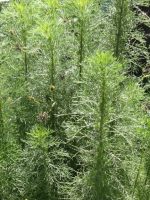 Also called sneezeweed, this herbaceous perennial is a member of the aster family, Asteraceae, that also includes sunflowers, daisies, and lettuce. It is native to eastern and south central US from Massachusetts to Florida west to Missouri and Texas where it is found in cultivated fields, abandoned fields, pastures, woodland margins, marshes, and waste areas. Although dogfennel grows best on moist well-drained soil in full sun to part shade, it tolerates most soil types and is drought tolerant.
Also called sneezeweed, this herbaceous perennial is a member of the aster family, Asteraceae, that also includes sunflowers, daisies, and lettuce. It is native to eastern and south central US from Massachusetts to Florida west to Missouri and Texas where it is found in cultivated fields, abandoned fields, pastures, woodland margins, marshes, and waste areas. Although dogfennel grows best on moist well-drained soil in full sun to part shade, it tolerates most soil types and is drought tolerant.
Description: Growing 4-6′ tall, dogfennel has erect, stiff, woody-based stems with short stout hairs that are reddish purple especially at the base. The deeply dissected leaves are pinnately divided into linear segments and emit a strong odor when crushed. The greenish white flower heads consist of three to six disc flowers and are arranged in large leafy pyramidal clusters. They appear in early fall and give rise to black glossy achenes with cream colored barbed bristles at one end. Plants spread by by lateral roots from a taproot and wind blown seeds.
Control: Control of dogfennel usually involve mowing before seed production followed by the application of herbicides such as a combination of dicamba and 2,4 D but herbicides like glyphosate are also effective. The timing of the herbicide application is all important to success but difficult to determine.